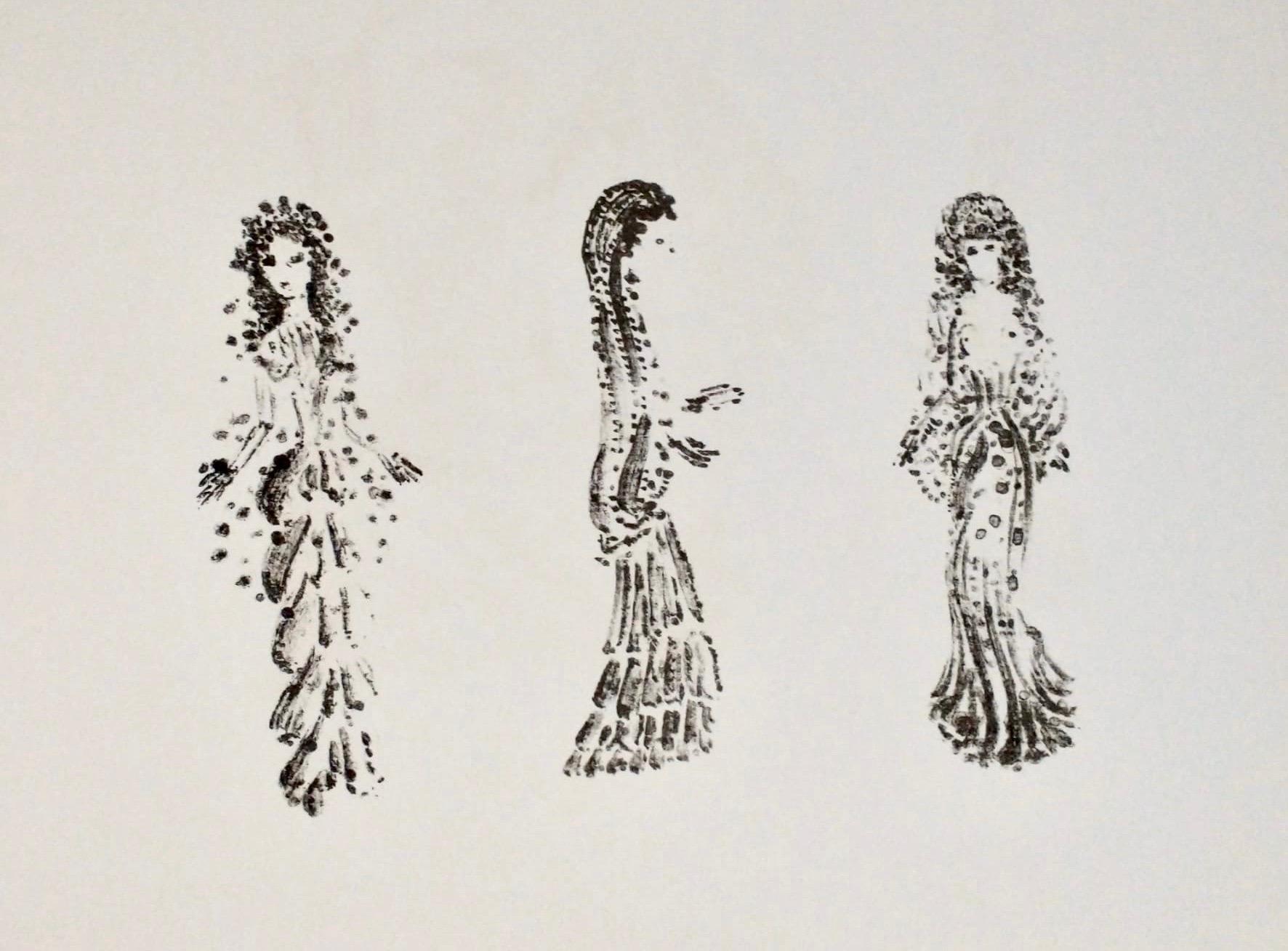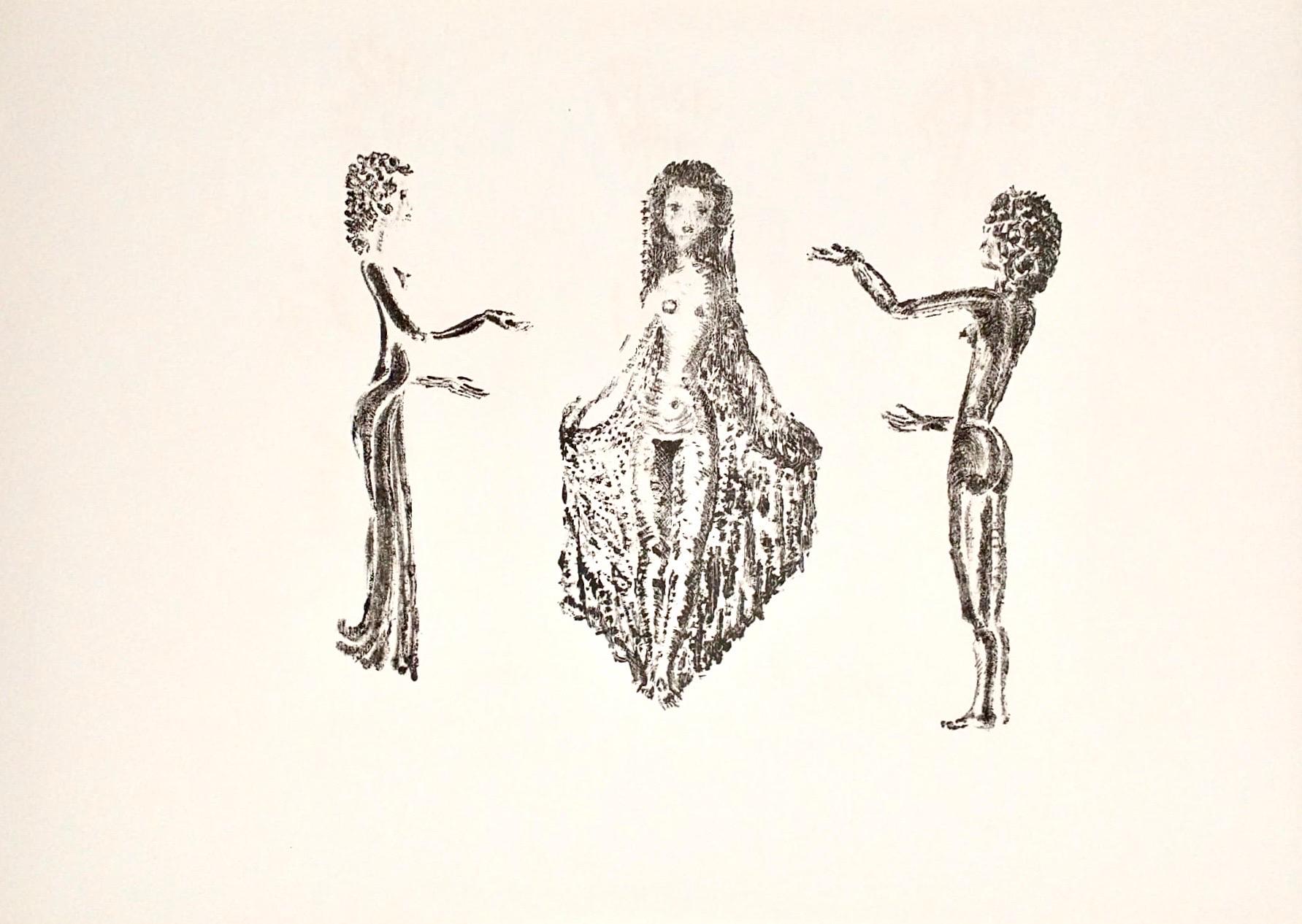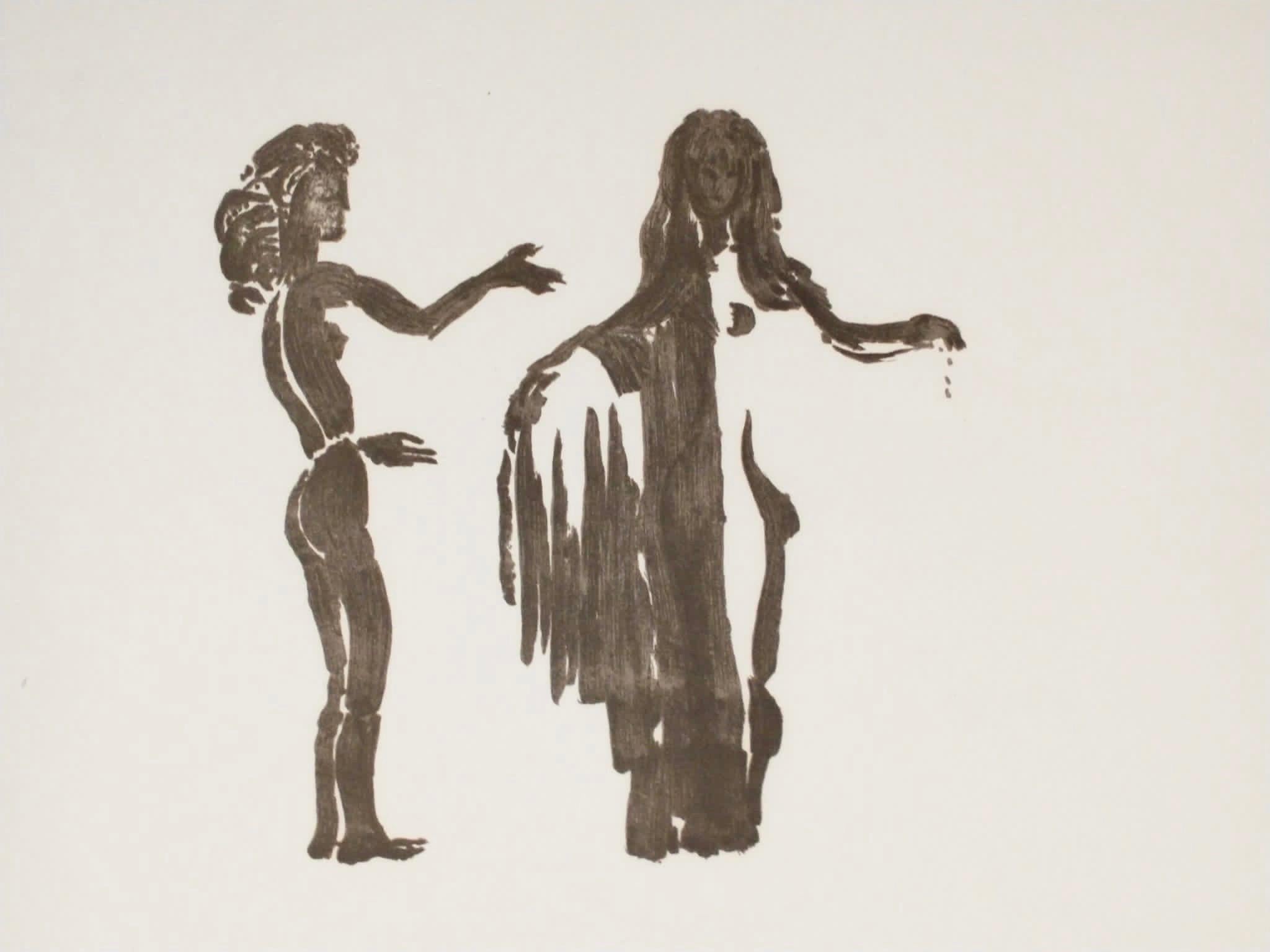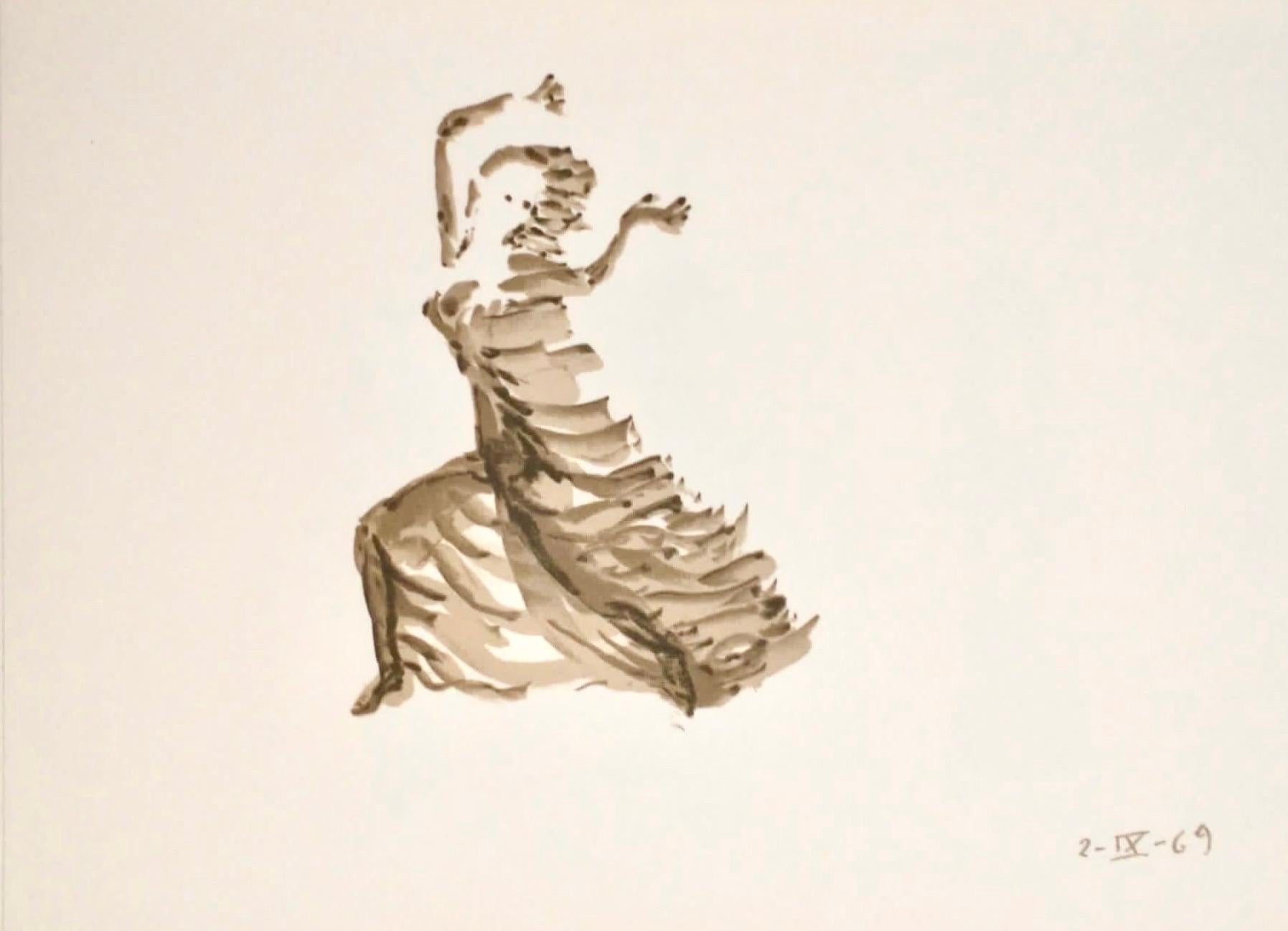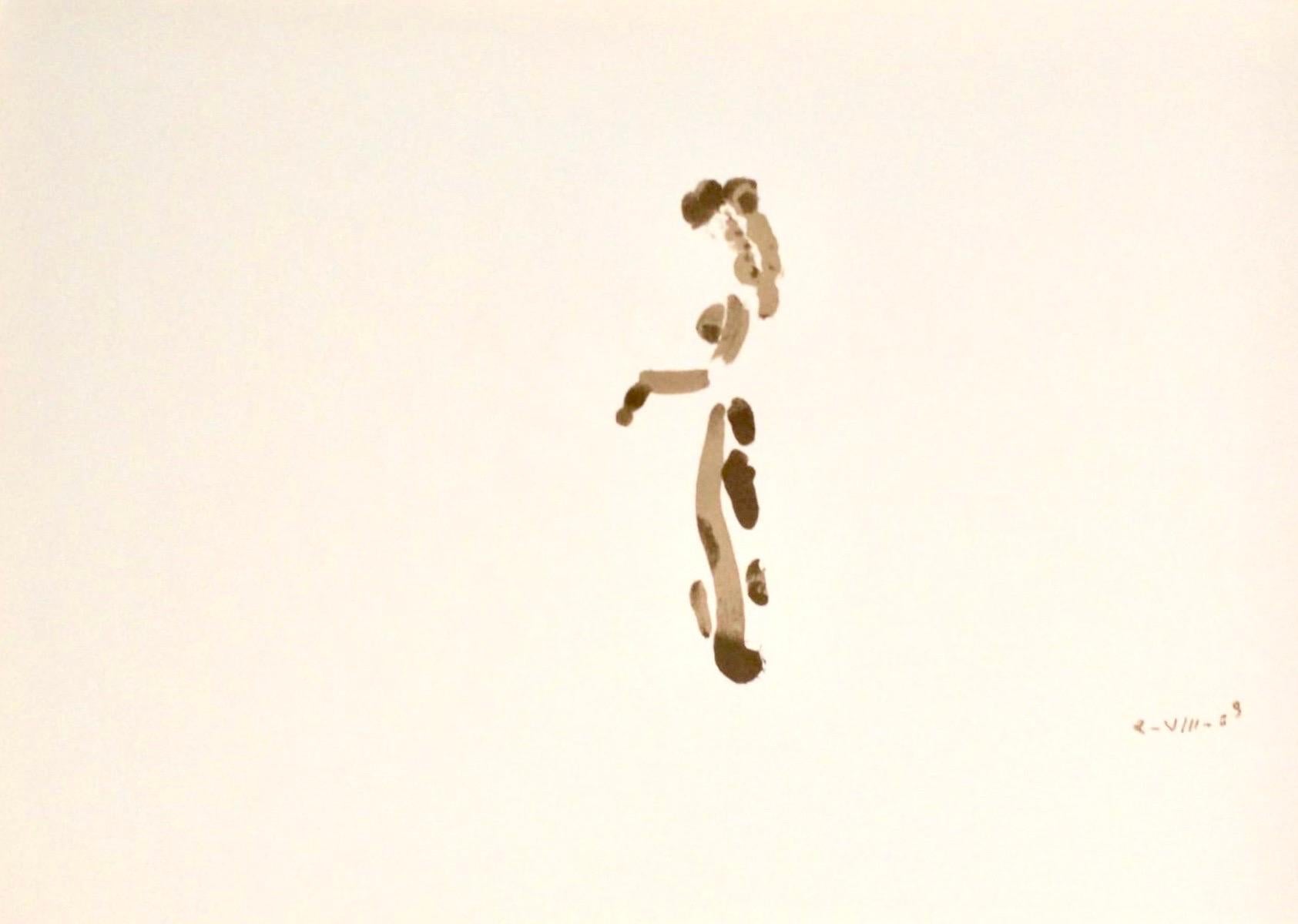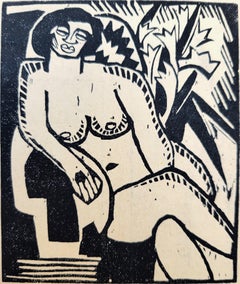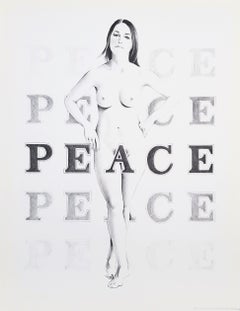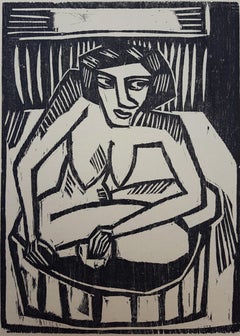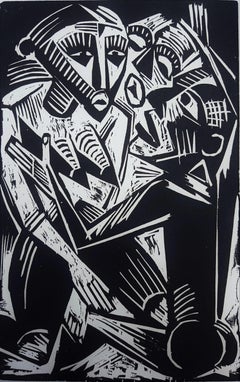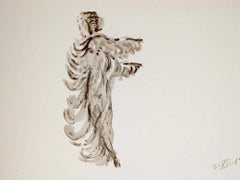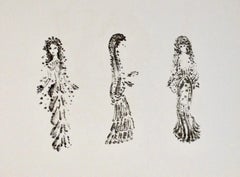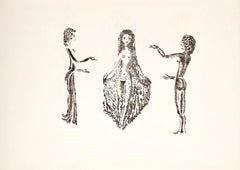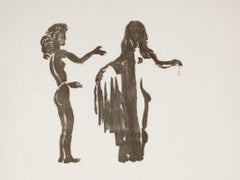Items Similar to Kunsthandel Wolfgang Werner KG (Nudes) /// German Expressionism Schmidt-Rottluff
Want more images or videos?
Request additional images or videos from the seller
1 of 23
(After) Karl Schmidt-RottluffKunsthandel Wolfgang Werner KG (Nudes) /// German Expressionism Schmidt-Rottluff1984
1984
About the Item
Artist: (after) Karl Schmidt-Rottluff (German, 1884-1976)
Title: "Kunsthandel Wolfgang Werner KG (Nudes)"
Year: 1984
Medium: Original Offset-Lithograph, Exhibition Poster on yellow wove paper
Limited edition: Unknown
Printer: Unknown
Publisher: Kunsthandel Wolfgang Werner KG, Bremen, Germany
Framing: Recently framed in a contemporary black moulding with frame space
Framed size: 29.25" x 19.5"
Sheet size: 27.25" x 17.75"
Image size: 9.5" x 12"
Condition: In excellent condition
Extremely rare
Notes:
Poster produced for a special posthumous exhibition of Rottluff's early watercolors and printmaking "Schmidt Rottluff" at Kunsthandel Wolfgang Werner KG, Bremen, Germany from March 8 - May 12, 1984, in tribute to the artist's, would have been, 100th birthday.
GIA Gallery Poster Disclaimer:
Not to be confused with thousands of contemporary inkjet/giclée/digital reproductions ignorantly or deliberately passed off as originals on the market today. The examples we offer here are the original period vintage (exhibition) posters, created and designed by, or under the supervision and authorization of the artist or their respective estate (posthumously), for various exhibitions and events in which they participated. If applicable, this poster is also fully documented within its respective artists' official catalogue raisonné of authentic graphic works, prints, and or posters.
Biography:
Karl Schmidt-Rottluff (born December 1, 1884, Rottluff, near Chemnitz, Germany—died August 9, 1976, West Berlin [now Berlin]), German painter and printmaker who was noted for his Expressionist landscapes and nudes.
In 1905 Schmidt-Rottluff began to study architecture in Dresden, Germany, where he and his friend Erich Heckel met Ernst Ludwig Kirchner and Fritz Bleyl, two other architecture students who shared their passion for painting. Together they formed the organization of Expressionist artists known as Die Brücke (“The Bridge”), united by the goal of creating a modern, intensely emotional style.
The artists of Die Brücke typically preferred to portray scenes of urban life, but Schmidt-Rottluff is particularly known for his rural landscapes. He initially painted in an Impressionist style, but his painting Windy Day (1907) shows the artist’s transition to his mature style, which is characterized by flat areas of boldly dissonant colours. A representative example of this mature work is Self-Portrait with Monocle (1910). Like the other Brücke artists, Schmidt-Rottluff had also begun to explore the expressive potential of the woodcut medium. In 1911 Schmidt-Rottluff, with his fellow Die Brücke members, moved to Berlin, where he painted works with more angular, geometric forms and distorted space, revealing his new interest in Cubism and African sculpture.
After World War I Schmidt-Rottluff became increasingly interested in religious themes, as seen in the woodcut Head of Christ (1918), which is one of a series of prints about the life of Christ. During the 1920s Schmidt-Rottluff’s work became more subdued and harmonious, losing much of its former vigour and integrity. When the Nazis gained power in Germany, he was forbidden to paint. After World War II he taught art and resumed painting, although he never regained the power of his early works.
- Creator:(After) Karl Schmidt-Rottluff
- Creation Year:1984
- Dimensions:Height: 29.25 in (74.3 cm)Width: 19.5 in (49.53 cm)
- Medium:
- Movement & Style:
- Period:
- Condition:
- Gallery Location:Saint Augustine, FL
- Reference Number:1stDibs: LU12124898782
About the Seller
5.0
Platinum Seller
Premium sellers with a 4.7+ rating and 24-hour response times
Established in 1978
1stDibs seller since 2015
1,307 sales on 1stDibs
Typical response time: <1 hour
- ShippingRetrieving quote...Shipping from: Saint Augustine, FL
- Return Policy
Authenticity Guarantee
In the unlikely event there’s an issue with an item’s authenticity, contact us within 1 year for a full refund. DetailsMoney-Back Guarantee
If your item is not as described, is damaged in transit, or does not arrive, contact us within 7 days for a full refund. Details24-Hour Cancellation
You have a 24-hour grace period in which to reconsider your purchase, with no questions asked.Vetted Professional Sellers
Our world-class sellers must adhere to strict standards for service and quality, maintaining the integrity of our listings.Price-Match Guarantee
If you find that a seller listed the same item for a lower price elsewhere, we’ll match it.Trusted Global Delivery
Our best-in-class carrier network provides specialized shipping options worldwide, including custom delivery.More From This Seller
View AllSitzende Frau mit Blüten (Seated Woman with Flowers) /// Karl Schmidt-Rottluff
By Karl Schmidt-Rottluff
Located in Saint Augustine, FL
Artist: (after) Karl Schmidt-Rottluff (German, 1884-1976)
Title: "Sitzende Frau mit Blüten (Seated Woman with Flowers)"
Series: Die Aktion
Year: 1914
Medium: The Complete Vol. 4, No. 11 issue of 'Die Aktion' with a Lithograph on cream smooth wove paper
Limited edition: Unknown
Printer: F.E. Haag, Melle, Hanover, Germany
Publisher: Verlag der Wochenschrift DIE AKTION, Berlin, Germany
Sheet size: 12.25" x 9.25"
Image size: 3.82" x 3.25"
Condition: Toning to sheets (as normal). Light water staining at center right edge and upper right corner. Some separation and small paper losses at spine. It is otherwise in very good condition
Extremely rare
A very nice copy of this extremely scarce issue
Notes:
Provenance: private collection - Fürstenberg/Havel, Germany. The lithograph on the cover is a smaller-sized reproduction after Schmidt-Rottluff's 1913 larger original signed woodcut engraving edition, ("Das Graphische Werk Bis 1923" - Schapire No. 114, page 28). Published March 14th, 1914. A total of 14 pages. There is an example of this complete issue in the permanent collection of the Museum of Modern Art, New York, NY.
In 1911 Franz Pfemfert, a cantankerous critic of capitalism and Wilhelmine society, founded Die Aktion as a political and literary journal. In April of the following year, a new subtitle declared the journal a "weekly for politics, literature, and art." Although politics remained the priority, Die Aktion began featuring visual art coverage as well as original prints and illustrations.
Artist Max Oppenheimer (MOPP) worked closely with 'Die Aktion' in its early years, portraying in its pages many of the young writers who gave the journal its distinctive voice. Egon Schiele made his first woodcuts at Pfemfert's urging in 1916, for publication in the journal. Other frequent contributors included Ludwig Meidner and, later, Conrad Felixmüller and Karl Schmidt-Rottluff.
Adamantly opposed to World War I, Pfemfert skirted tightened censorship from August 1914 to October 1918 by treating contemporary events only through artistic and literary allusions. At a time when reading books by foreign authors was considered unpatriotic, he dedicated entire issues of Die Aktion to Russian, French, and Belgian authors and artists. In late 1918, however, Pfemfert resumed vocal political critique, siding with the radical left. His selection of prints, formerly varied, became overtly political. After 1921, he ceased art coverage altogether, decreased the number of issues, and used the publication exclusively as a mouthpiece for his own increasingly partisan views.
Biography:
Karl Schmidt-Rottluff (born December 1, 1884, Rottluff, near Chemnitz, Germany—died August 9, 1976, West Berlin [now Berlin]), German painter and printmaker who was noted for his Expressionist landscapes and nudes.
In 1905 Schmidt-Rottluff began to study architecture in Dresden, Germany, where he and his friend Erich Heckel met Ernst Ludwig Kirchner and Fritz Bleyl...
Category
1910s Expressionist Nude Prints
Materials
Lithograph
Peace /// Mel Ramos Figurative Woman Nude Pop Art Typography Lithograph Print
By Mel Ramos
Located in Saint Augustine, FL
Artist: Mel Ramos (American, 1935-2018)
Title: "Peace"
*Unsigned edition
Year: 1970
Medium: Original Offset-Lithograph on light smooth wove paper
Limited edition: 50, (there was also...
Category
1970s Pop Art Nude Prints
Materials
Lithograph, Offset
Frau in der Wanne (Woman in Tub) /// German Expressionism Schmidt-Rottluff Nude
By Karl Schmidt-Rottluff
Located in Saint Augustine, FL
Artist: Karl Schmidt-Rottluff (German, 1884-1976)
Title: "Frau in der Wanne (Woman in Tub)"
Series: Die Aktion
*Unsigned edition
Year: 1915
Medium: Original Woodcut Engraving on cream smooth wove paper
Limited edition: Unknown, (there was also a signed edition on laid paper with wider margins in an unknown edition size)
Printer: F.E. Haag, Melle, Hanover, Germany
Publisher: Verlag der Wochenschrift DIE AKTION, Berlin, Germany
Reference: "Das Graphische Werk Bis 1923" - Schapire No. 171, page 37; Söhn No. 40502
Framing: Recently framed in a contemporary gold moulding with 100% cotton rag matting and Artglass
Framed size: 16" x 13.25"
Sheet size: 11.5" x 8.75"
Image size: 10" x 7.25"
Condition: Faint UV staining to sheet and light toning at edges. It is otherwise a strong impression in excellent condition
Extremely rare
Notes:
Provenance: private collection - Kiel, Germany. Comes from the famous "Die Aktion" publication, Vol. 5, No. 13 published March 20th, 1915. There is an example of this complete issue in the permanent collection of the Museum of Modern Art, New York, NY.
In 1911 Franz Pfemfert, a cantankerous critic of capitalism and Wilhelmine society, founded Die Aktion as a political and literary journal. In April of the following year, a new subtitle declared the journal a "weekly for politics, literature, and art." Although politics remained the priority, Die Aktion began featuring visual art coverage as well as original prints and illustrations.
Artist Max Oppenheimer...
Category
1910s Expressionist Nude Prints
Materials
Woodcut, Engraving
Weib Vom Manne Begehrt (Woman Desired by Man) /// Max Pechstein Woodcut Modern
By Hermann Max Pechstein
Located in Saint Augustine, FL
Artist: Hermann Max Pechstein (German, 1881-1955)
Title: "Weib Vom Manne Begehrt (Woman Desired by Man)"
Portfolio: Deutsche Grapiker der Gegenwart (German Printmakers of Our Time)
*Unsigned edition
Year: 1919, (published 1920)
Medium: Original Woodcut Engraving on cream wove paper
Limited edition: 500, (there was also a signed and numbered edition of 30)
Printer: Unknown
Publisher: Klinkhardt & Biermann, Leipzig, Germany
Reference: "Das Graphische Werk Max Pechsteins" - Krüger No. 224; Fechter No. 157; Rifkind No. 2252; Söhn I, page 108-114
Sheet size: 12.75" x 9.5"
Image size: 9.88" x 6.25"
Condition: One small skillfully repaired tear lower left in margin. It is otherwise a strong impression in excellent condition
Notes:
Provenance: private collection - Kiel, Germany. Comes from the 1920 "Deutsche Grapiker der Gegenwart (German Printmakers of Our Time)" portfolio of fifteen lithographs, eight woodcuts, eight reproductions, and one lithographed cover by various artists. The artists who contributed to this portfolio were George Grosz, Ernst Barlach, Lovis Corinth, Richard Seewald, Heinrich Campendonk, Erich Heckel, Otto Mueller, Karl Schmidt-Rottluff, Lyonel Feininger, Conrad Felixmüller, Max Unold, Karl Caspar, Max Lieberman, René Beeh, Adolf Ferdinand Schinnerer, Ludwig Meidner, Max Beckmann, Richard Seewald, Käthe Kollwitz, August Gaul, Rudolf Grossman, Alfred Kubin, and Paul Klee. This very same work is within many permanent museum collections including the Museum of Modern Art, New York, NY.
"Deutsche Graphiker der Gegenwart (German Printmakers of Our Time)" brings together woodcuts, lithographs, and reproductions by thirty-one artists representing a cross-section of styles from Impressionism to Expressionism, uniting under a single cover works ranging from naturalistic self-portraits to left-wing political caricatures. It features works by artists associated with the Berlin Secession (an exhibiting society comprised primarily of German Impressionists), with Expressionist groups like the Brücke and Der Blaue Reiter, and with the political Novembergruppe, as well as artists like Max Beckmann who were not affliliated with any group.
In his introduction, art historian Kurt Pfister identified Expressionism as the leading force in German art at the time, while stressing the plurality of approaches to style and subject matter that the movement encompassed. Pfister emphasized the openness of German artists to foreign sources, and cited the importance of Paul Cézanne, Edvard Munch, and Pablo Picasso as well as Japanese, Indian, African, and Gothic art for the development of German art. There was a fifty-year difference in age between the oldest artist, Max Liebermann, and the youngest, Conrad Felixmüller, featured in the collection. The volume also included Lyonel Feininger, an American who had lived in Germany since 1896, as well as Austrian artists Oskar Kokoschka and Alfred Kubin.
Biography:
Pechstein was born in Zwickau, the son of a craftsman who worked in a textile mill. Early contact with the art of Vincent van Gogh stimulated Pechstein's development toward expressionism. After studying art first at the School of Applied Arts and then at the Royal Art Academy in Dresden, Pechstein met Erich Heckel and joined the art group Die Bru¨cke in 1906. He was the only member to have formal art training. Later in Berlin, he helped to found the Neue Sezession and gained recognition for his decorative and colorful paintings that were lent from the ideas of Van Gogh, Matisse, and the Fauves. His paintings eventually became more primitivist, incorporating thick black lines and angular figures.
From in 1933, Pechstein was vilified by the Nazis because of his art. A total of 326 of his paintings were removed from German museums. Sixteen of his works were displayed in the Entartete Kunst (Degenerate Art...
Category
1920s Expressionist Nude Prints
Materials
Engraving, Woodcut
Stehendes nacktes Mädchen im Profil (Standing Naked Girl in Profile) /// Woodcut
By Karl Schmidt-Rottluff
Located in Saint Augustine, FL
Artist: Karl Schmidt-Rottluff (German, 1884-1976)
Title: "Stehendes nacktes Mädchen im Profil (Standing Naked Girl in Profile)"
Portfolio: Das Spiel Christa vom Schmerz der Schönheit des Weibes (The Play Christa from the Pain of the Beauty of the Woman)
*Issued unsigned
Year: 1918
Medium: Original Woodcut Engraving on wove paper
Limited edition: Unknown
Printer: Fritz Voigt, Berlin, Germany
Publisher: Verlag Die Aktion, Berlin, Germany
Reference: Schapire No. 220, page 45; Jentsch No. 35. Rifkind No. 2563; Lang No. 300; Reed No. 118
Sheet size: 8.5" x 5.38"
Image size: 6.5" x 3.57"
Condition: Toning to sheet (as normal). In very good condition
Very rare
Notes:
Provenance: private collection - Oxnard, CA. Comes from a complete originally bound 48 page folio with 9 original woodcut engravings by Schmidt-Rottluff. Text by Alfred Brust. The cover and title pages in pictures are not included, only for reference/provenance. There is an example of this work in the permanent collection of the Brücke Museum, Berlin, Germany.
Biography:
Karl Schmidt-Rottluff (born December 1, 1884, Rottluff, near Chemnitz, Germany—died...
Category
1910s Expressionist Nude Prints
Materials
Engraving, Woodcut
Bekleidete und nackte Frau (Clothed and Naked Woman) /// German Expressionism
By Karl Schmidt-Rottluff
Located in Saint Augustine, FL
Artist: Karl Schmidt-Rottluff (German, 1884-1976)
Title: "Bekleidete und nackte Frau (Clothed and Naked Woman)"
Portfolio: Das Spiel Christa vom Schmerz der Schönheit des Weibes (The Play Christa from the Pain of the Beauty of the Woman)
*Issued unsigned
Year: 1918
Medium: Original Woodcut Engraving on wove paper
Limited edition: Unknown
Printer: Fritz Voigt, Berlin, Germany
Publisher: Verlag Die Aktion, Berlin, Germany
Reference: Schapire No. 221, page 45; Jentsch No. 35. Rifkind No. 2563; Lang No. 300; Reed No. 118
Overall size with attached page: 8.5" x 10.63"
Sheet size: 8.5" x 5.38"
Image size: 6.5" x 3.38"
Condition: Toning to sheet (as normal). In very good condition
Very rare
Notes:
Provenance: private collection - Oxnard, CA. Comes from a complete originally bound 48 page folio with 9 original woodcut engravings by Schmidt-Rottluff. Text by Alfred Brust. Presently attached to its accompanying page. The cover and title pages in pictures are not included, only for reference/provenance. There is an example of this work in the permanent collection of the Brücke Museum, Berlin, Germany.
Biography:
Karl Schmidt-Rottluff (born December 1, 1884, Rottluff, near Chemnitz, Germany—died...
Category
1910s Expressionist Nude Prints
Materials
Engraving, Woodcut
You May Also Like
Apeles Fenosa Spanish Sculptor Mourlot Lithograph Abstract Expressionist Figures
By Apelles Fenosa
Located in Surfside, FL
This is from a hand signed, limited edition (edition of 125) folio or full page lithographs some having a poem verso. The individual sheets are not signed or numbered. This listing is just for the one sheet, not for the cover sheet or the signed sheet.
This was printed at Mourlot in Paris, France, on velin D'Arches paper.
Apel les Fenosa i Florensa (1899 - 1989) lived in Spain. Apelles Fenosa is known for Expressionist Sculpture.
Artist's alternative names: Apel·les Fenosa, Apelles Fenosa
Spanish...
Category
1970s Expressionist Figurative Prints
Materials
Lithograph
Apeles Fenosa Spanish Sculptor Mourlot Lithograph Abstract Expressionist Figures
By Apelles Fenosa
Located in Surfside, FL
This is from a hand signed, limited edition (edition of 125) folio or full page lithographs some having a poem verso. The individual sheets are not signed or numbered. This listing is just for the one sheet, not for the cover sheet or the signed sheet.
This was printed at Mourlot in Paris, France, on velin D'Arches paper.
Apel les Fenosa i Florensa (1899 - 1989) lived in Spain. Apelles Fenosa is known for Expressionist Sculpture.
Artist's alternative names: Apel·les Fenosa, Apelles Fenosa
Spanish Sculptor Fenosa was born in Barcelona, Spain in 1899 and as a young man worked in the studio of sculptor Enrique Casanovas where he came into contact with the ideas and adherents of the Modernist Movement and its influence in Barcelona, Paris and other European cities. In 1917 he founded together with Joan Rebull, Josep Granyer and Josep Viladomat the group The Evolutionists. He arrived in Paris in 1921. There he quickly gravitated into the Parisian avant garde artist community and became friends with Pablo Picasso, who became an early patron of his work, buying a significant number of his sculptures, and with the sculptor Max Jacob. By 1924 Fenosa was exhibiting in Paris and in his native city of Barcelona. Max Jacob wrote the preface to the catalogs of Fenosa's first Paris exhibition, and his show at the Zborowski gallery in 1928. In 1931 Fenosa was in Catalonia when the Second Spanish Republic was declared. There he remained in order to work with the anarchist movement and participate in the Republican ranks during the Spanish Civil War. He participated in the Venice Biennale in 1936 and with the coming to power of the Franco Fascist regime left Spain once again to settle in Paris. In 1942, he met the painter and poet, Paul Eluard, who became a close friend.
In 1944, the Comite de Liberation du Limousin (Organization for the Liberation of the Limousin) commissions a sculpture to commemorate the Nazi killings of Oradour-sur-Glane. He creates the "Monument aux Martyrs d'Oradour-sur-Glane" (Monument to the Martyrs of Oradour) presently in Limoges.
From 1946 Fenosa exhibited individually or collectively in Paris, London, Barcelona, Madrid, Prague, New York, Tokyo, Rabat, Osaka, Casablanca, Carrara.
His personal exhibition catalogs are prefaced by the most famous writers and poets of his time, including Paul Eluard, Jean Cocteau, Jules Supervielle, Josep Carner, Alexandre Cirici-Pellicer, Francis Ponge, Pablo Neruda, Michel Cournot, Roger Caillois, Salvador Espriu. He was part of a generation of Spanish and Catalan artists that included Jose Amat Pages, Ramon Pichot, Alfredo Opisso Cardona, Ramon Aguilar More, Juan Cardona Llados, Josep Miquel Serrano, Ignacio Zuloaga Y Zabaleta, Andre Beaudin, Francisco Domingo Y Segura, Jose Armet Y Portanel, Jose Ventosa Domenech, Antonio Vila Arrufat, Montserrat Gudiol Corominas, Juan Abello Prat, Francesc Artigau.
In 1981, the UNESCO commissions a bronze sculpture given every year to the laureate of the Unesco Prize for Peace Education. Fenosa creates L'Olivier, the "Olive Tree", symbol of peace and attribute of the poet. In 1982, he receives the Gold Medal of the Government of Catalonia, in 1983 the Legion d'Honneur ( French Legion of Honour) and in 1987 the Gold Medal of Barcelona.
He is commissioned to make a bronze sculpture award for the Joan Crexells Narrative Prize, the premier Catalan language literary prize awarded by the Ateneo Barcelonés to the best narrative work in Catalan published during the previous year.
Selected Solo Exhibitions
2021 Apel·Les Fenosa ,Galeria Marc Domenech ,Barcelona, Spain
Selected Group Exhibitions
2022 Figurative Expressionism ,Galeria Marc Domenech ,Barcelona, Spain (with Josep Guinovart and Jean Dubuffet)
2021 The point of sculpture ,Fundació Joan Miro ,Barcelona, Spain
2019 Picasso and the Exodus. A history of Spanish art in resistance, Les Abattoirs ,Toulouse, France (with Oscar Dominguez, Antoni Clavé, Josep Renau...
Category
1970s Expressionist Figurative Prints
Materials
Lithograph
Apeles Fenosa Spanish Sculptor Mourlot Lithograph Abstract Expressionist Figures
By Apelles Fenosa
Located in Surfside, FL
This is from a hand signed, limited edition (edition of 125) folio or full page lithographs some having a poem verso. The individual sheets are not signed or numbered. This listing is just for the one sheet, not for the cover sheet or the signed sheet.
This was printed at Mourlot in Paris, France, on velin D'Arches paper.
Apel les Fenosa i Florensa (1899 - 1989) lived in Spain. Apelles Fenosa is known for Expressionist Sculpture.
Artist's alternative names: Apel·les Fenosa, Apelles Fenosa
Spanish Sculptor Fenosa was born in Barcelona, Spain in 1899 and as a young man worked in the studio of sculptor Enrique Casanovas where he came into contact with the ideas and adherents of the Modernist Movement and its influence in Barcelona, Paris and other European cities. In 1917 he founded together with Joan Rebull, Josep Granyer and Josep Viladomat the group The Evolutionists. He arrived in Paris in 1921. There he quickly gravitated into the Parisian avant garde artist community and became friends with Pablo Picasso, who became an early patron of his work, buying a significant number of his sculptures, and with the sculptor Max Jacob. By 1924 Fenosa was exhibiting in Paris and in his native city of Barcelona. Max Jacob wrote the preface to the catalogs of Fenosa's first Paris exhibition, and his show at the Zborowski gallery in 1928. In 1931 Fenosa was in Catalonia when the Second Spanish Republic was declared. There he remained in order to work with the anarchist movement and participate in the Republican ranks during the Spanish Civil War. He participated in the Venice Biennale in 1936 and with the coming to power of the Franco Fascist regime left Spain once again to settle in Paris. In 1942, he met the painter and poet, Paul Eluard, who became a close friend.
In 1944, the Comite de Liberation du Limousin (Organization for the Liberation of the Limousin) commissions a sculpture to commemorate the Nazi killings of Oradour-sur-Glane. He creates the "Monument aux Martyrs d'Oradour-sur-Glane" (Monument to the Martyrs of Oradour) presently in Limoges.
From 1946 Fenosa exhibited individually or collectively in Paris, London, Barcelona, Madrid, Prague, New York, Tokyo, Rabat, Osaka, Casablanca, Carrara.
His personal exhibition catalogs are prefaced by the most famous writers and poets of his time, including Paul Eluard, Jean Cocteau, Jules Supervielle, Josep Carner, Alexandre Cirici-Pellicer, Francis Ponge, Pablo Neruda, Michel Cournot, Roger Caillois, Salvador Espriu. He was part of a generation of Spanish and Catalan artists that included Jose Amat Pages, Ramon Pichot, Alfredo Opisso Cardona, Ramon Aguilar More, Juan Cardona Llados, Josep Miquel Serrano, Ignacio Zuloaga Y Zabaleta, Andre Beaudin, Francisco Domingo Y Segura, Jose Armet Y Portanel, Jose Ventosa Domenech, Antonio Vila Arrufat, Montserrat Gudiol Corominas, Juan Abello Prat, Francesc Artigau.
In 1981, the UNESCO commissions a bronze sculpture given every year to the laureate of the Unesco Prize for Peace Education. Fenosa creates L'Olivier, the "Olive Tree", symbol of peace and attribute of the poet. In 1982, he receives the Gold Medal of the Government of Catalonia, in 1983 the Legion d'Honneur ( French Legion of Honour) and in 1987 the Gold Medal of Barcelona.
He is commissioned to make a bronze sculpture award for the Joan Crexells Narrative Prize, the premier Catalan language literary prize awarded by the Ateneo Barcelonés to the best narrative work in Catalan published during the previous year.
Selected Solo Exhibitions
2021 Apel·Les Fenosa ,Galeria Marc Domenech ,Barcelona, Spain
Selected Group Exhibitions
2022 Figurative Expressionism ,Galeria Marc Domenech ,Barcelona, Spain (with Josep Guinovart and Jean Dubuffet)
2021 The point of sculpture ,Fundació Joan Miro ,Barcelona, Spain
2019 Picasso and the Exodus. A history of Spanish art in resistance, Les Abattoirs ,Toulouse, France (with Oscar Dominguez, Antoni Clavé, Josep Renau...
Category
1970s Expressionist Figurative Prints
Materials
Lithograph
Apeles Fenosa Spanish Sculptor Mourlot Lithograph Abstract Expressionist Figures
By Apelles Fenosa
Located in Surfside, FL
This is from a hand signed, limited edition (edition of 125) folio or full page lithographs with a poem verso. The individual sheets are not signed or numbered. This listing is just...
Category
1970s Expressionist Figurative Prints
Materials
Lithograph
Apeles Fenosa Spanish Sculptor Mourlot Lithograph Abstract Expressionist Figures
By Apelles Fenosa
Located in Surfside, FL
This is from a hand signed, limited edition (edition of 125) folio or full page lithographs some having a poem verso. The individual sheets are not signed or numbered. This listing is just for the one sheet, not for the cover sheet or the signed sheet.
This was printed at Mourlot in Paris, France, on velin D'Arches paper.
Apel les Fenosa i Florensa (1899 - 1989) lived in Spain. Apelles Fenosa is known for Expressionist Sculpture.
Artist's alternative names: Apel·les Fenosa, Apelles Fenosa
Spanish Sculptor Fenosa was born in Barcelona, Spain in 1899 and as a young man worked in the studio of sculptor Enrique Casanovas where he came into contact with the ideas and adherents of the Modernist Movement and its influence in Barcelona, Paris and other European cities. In 1917 he founded together with Joan Rebull, Josep Granyer and Josep Viladomat the group The Evolutionists. He arrived in Paris in 1921. There he quickly gravitated into the Parisian avant garde artist community and became friends with Pablo Picasso, who became an early patron of his work, buying a significant number of his sculptures, and with the sculptor Max Jacob. By 1924 Fenosa was exhibiting in Paris and in his native city of Barcelona. Max Jacob wrote the preface to the catalogs of Fenosa's first Paris exhibition, and his show at the Zborowski gallery in 1928. In 1931 Fenosa was in Catalonia when the Second Spanish Republic was declared. There he remained in order to work with the anarchist movement and participate in the Republican ranks during the Spanish Civil War. He participated in the Venice Biennale in 1936 and with the coming to power of the Franco Fascist regime left Spain once again to settle in Paris. In 1942, he met the painter and poet, Paul Eluard, who became a close friend.
In 1944, the Comite de Liberation du Limousin (Organization for the Liberation of the Limousin) commissions a sculpture to commemorate the Nazi killings of Oradour-sur-Glane. He creates the "Monument aux Martyrs d'Oradour-sur-Glane" (Monument to the Martyrs of Oradour) presently in Limoges.
From 1946 Fenosa exhibited individually or collectively in Paris, London, Barcelona, Madrid, Prague, New York, Tokyo, Rabat, Osaka, Casablanca, Carrara.
His personal exhibition catalogs are prefaced by the most famous writers and poets of his time, including Paul Eluard, Jean Cocteau, Jules Supervielle, Josep Carner, Alexandre Cirici-Pellicer, Francis Ponge, Pablo Neruda, Michel Cournot, Roger Caillois, Salvador Espriu. He was part of a generation of Spanish and Catalan artists that included Jose Amat Pages, Ramon Pichot, Alfredo Opisso Cardona, Ramon Aguilar More, Juan Cardona Llados, Josep Miquel Serrano, Ignacio Zuloaga Y Zabaleta, Andre Beaudin, Francisco Domingo Y Segura, Jose Armet Y Portanel, Jose Ventosa Domenech, Antonio Vila Arrufat, Montserrat Gudiol...
Category
1970s Expressionist Figurative Prints
Materials
Lithograph
Apeles Fenosa Spanish Sculptor Mourlot Lithograph Abstract Expressionist Figures
By Apelles Fenosa
Located in Surfside, FL
This is from a hand signed, limited edition (edition of 125) folio or full page lithographs some having a poem verso. The individual sheets are not signed or numbered. This listing ...
Category
1970s Expressionist Figurative Prints
Materials
Lithograph

